by Eric Meier
When attempting to identify a wood sample, it’s important to keep in mind the limitations and obstacles that are present in our task. Before starting, please have a look at The Truth Behind Wood Identification to approach the task in a proper mindset; I consider the linked article to be required reading for all those visiting my site with the intent of identifying wood.
1. Confirm it is actually solid wood.
Before proceeding too much farther into the remaining steps, it’s first necessary to confirm that the material in question is actually a solid piece of wood, and not a man-made composite or piece of plastic made to imitate wood.
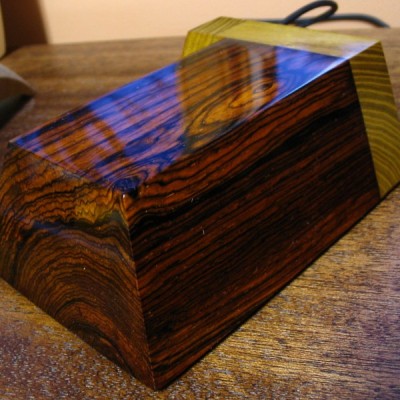
Can you see the end-grain?
Manufactured wood such as MDF, OSB, and particleboard all have a distinct look that is—in nearly all cases—easily distinguishable from the endgrain of real wood. Look for growth rings—formed by the yearly growth of a tree—which will be a dead-giveaway that the wood sample in question is a solid, genuine chunk of wood taken from a tree.
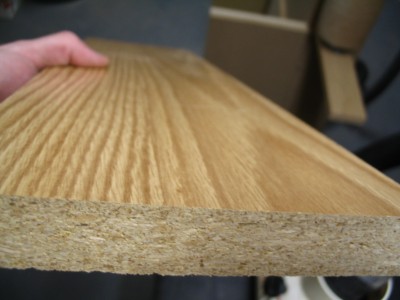
Is it veneered?
If you see a large panel that has a repeating grain pattern, it may be a veneer. In such cases, a very thin layer of real wood is peeled from a tree and attached to a substrate; sometimes the veneer can be one continuous repeating piece because it is rotary-sliced to shave off the veneer layer as the tree trunk is spun by machines. Assuming it is a real wood veneer with a distinct grain and texture—and not merely a piece of printed plastic—you may still be able to identify the outer veneer wood in question, but you should still realize that is it only a veneer and not a solid piece of wood.
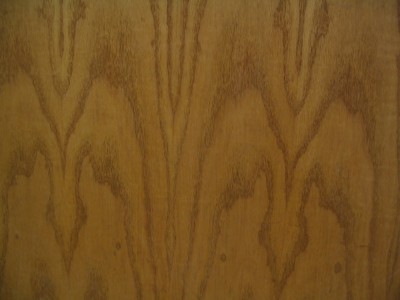
Is it painted or printed to look like wood?
Many times, especially on medium to large-sized flat panels for furniture, a piece of particleboard or MDF is either laminated with a piece of wood-colored plastic, or simply painted to look like wood grain. Many of today’s interior hardwood flooring planks are good examples of these pseudo-wood products: they are essentially a man-made material made of sawdust, glues, resins, and durable plastics.
2. Look at the color.
Some questions to immediately ask yourself:
Is the color of the wood natural, or is it stained?
If there is even a chance that the color isn’t natural, the odds are increased that the entire effort of identifying the wood will be in vain.
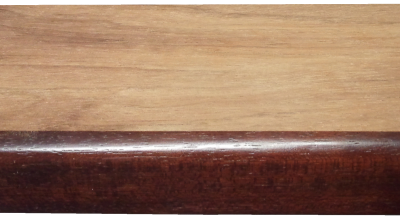
Is it weathered or have a patina?
Many woods, when left outside in the elements, tend to turn a bland gray color. Also, even interior wood also takes on a patina as it ages: some woods get darker, or redder, and some even get lighter or lose their color; but for the most part, wood tends to darken with age.
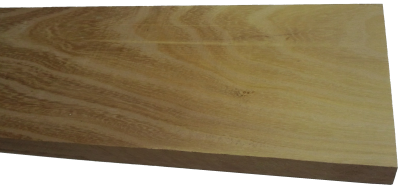
Is it possible to sand or plane the board to see the natural raw color of the wood?
The most predictable baseline to use when identifying wood is in a freshly sanded state. This eliminates the chances of a stain or natural aging skewing the color diagnosis of the wood.
3. Observe the wood grain.
If the wood is unfinished, then look at the texture of the grain. Ask yourself these questions:
Does the wood have an open, porous texture?
Most softwoods will be almost perfectly smooth with no grain indentations, while many common hardwoods have an open pore structure, such as oak or mahogany; though there are some hardwoods that are also smooth to the touch, such as maple.
Can you tell if the wood is quartersawn or plainsawn?
By observing the grain patterns, many times you can tell how the board was cut from the tree. Some wood species have dramatically different grain patterns from plainsawn to quartersawn surfaces. For instance, on their quartersawn surfaces, lacewood has large lace patterns, oak has flecks, and maple has the characteristic “butcher block” appearance.
Is there any figure or unusual characteristics, such as sapwood, curly or wild grain, burl/knots, etc.?
Some species of wood have figure that is much more common than in other species: for example, curly figure is fairly common in soft maple, and the curls are usually well-pronounced and close together. Yet when birch or cherry has a curly grain, it is more often much less pronounced, and the curls are spaced farther apart.
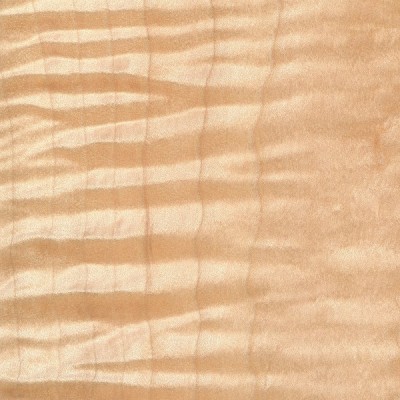
4. Consider the weight and hardness of the wood.
If it’s possible, pick the piece of wood up and get a sense of its weight, and compare it to other known wood species. Try gouging the edge with your fingernail to get a sense of its hardness. If you have a scale, you can take measurements of the length, width, and thickness of the wood, and combine them to find the density of the wood. This can be helpful to compare to other density readings found in the database. When examining the wood in question, compare it to other known wood species, and ask yourself these questions:
Is the wood dry?
Wood from freshly felled trees, or wood that has been stored in an extremely humid environment will have very high moisture contents. In some freshly sawn pieces, moisture could account for over half of the wood’s total weight! Likewise, wood that has been stored in extremely dry conditions of less than 25% relative humidity will most likely feel lighter than average.
How does the wood’s weight compare to other species?
Taking into account the size of the board, how does its weight compare to other benchmark woods? Is it heavier than oak? Is it lighter than pine? Look at the weight numbers for a few wood species that are close to yours, and get a ballpark estimate of its weight.
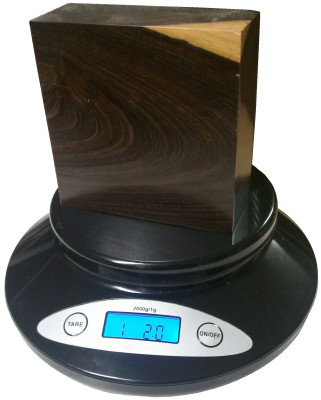
How hard is the wood?
Obviously softwoods will tend to be softer than hardwoods, but try to get a sense of how it compares to other known woods. Density and hardness are closely related, so if the wood is heavy, it will most likely be hard too. If the wood is a part of a finished item that you can’t adequately weigh, you might be able to test the hardness by gouging it in an inconspicuous area. Also, if it is used in a piece of furniture, such as a tabletop, a general idea of its hardness can be assessed by the number and depth of the gouges/dings in the piece given its age and use. A tabletop made of pine will have much deeper dents than a tabletop made of Oak. Additionally, you can always try the “fingernail test” as a rough hardness indicator: find a crisp edge of the wood, and with your fingernail try to push in as hard as you can and see if you’re able to make a dent in the wood.
5. Consider its history.
Many times we forget common sense and logic when attempting to identify wood. If you’ve got a piece of Amish furniture from Pennsylvania, chances are more likely that the wood will be made of something like black walnut or cherry, and not African wenge or jatoba. You might call it “wood profiling,” but sometimes it can pay to be a little prejudiced when it comes to wood identification. Some common-sense questions to ask yourself when trying to identify a piece of wood:
Where did it come from?
Knowing as much as you can about the source of the wood—even the smallest details—can be helpful. If the wood came from a wood pile or a lumber mill where all the pieces were from trees processed locally, then the potential species are immediately limited. If the wood came from a builder of antique furniture, or a boat-builder, or a trim carpenter: each of these occupations will tend to use certain species of woods much more often than others, making a logical guess much simpler.
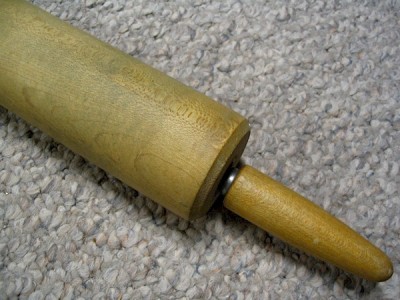
How old is it?
As with the wood’s source, its age will also help in identification purposes. Not only will it help to determine if the wood should have developed a natural patina, but it will also suggest certain species which were more prevalent at different times in history. For instance, many acoustic guitars made before the 1990s have featured Brazilian rosewood backs/sides, yet due to CITES restrictions placed upon that species, East Indian rosewood became a much more common species on newer guitars. (And this is a continuing shift as newer replacements are sought for rosewoods altogether.)
How large is the piece of wood?
Some species of trees are typically very small—some are even considered shrubs—while others get quite large. For instance, if you see a large panel or section of wood that’s entirely black, chances are it’s either painted, dyed, or stained: Gaboon ebony and related species are typically very small and very expensive.
What is the wood’s intended use?
Simply knowing what the wood was intended for—when considered in conjunction with where it came from and how old it is—can give you many clues to help identify it. In some applications, certain wood species are used much more frequently than others, so that you can make an educated guess as to the species of the wood based upon the application where it was used. For instance, in the United States: many older houses with solid hardwood floors have commonly used either red oak or hard maple; many antique furniture pieces have featured quartersawn white oak; many violins have spruce tops; many closet items used aromatic red cedar, and so forth. While it’s not a 100% guarantee, “profiling” the wood in question will help reduce the number of possible suspects, and aid in deducing the correct species.
6. Find the X-Factor.
Sometimes, after all the normal characteristics of a sample have been considered, the identity of the wood in question is still not apparent. In these instances—particularly in situations where a sample has been narrowed down to only a few possible remaining choices—it’s sometimes helpful to bring in specialized tests and other narrower means of identification.
The following techniques and recommendations don’t necessarily have a wide application in initially sorting out wood species and eliminating large swaths of wood species, but will most likely be of use only as a final step in special identification circumstances.
Odor
Believe it or not, freshly machined wood can have a very identifiable scent. When your eyes and hands can’t quite get a definitive answer, sometimes your nose can. Assuming there is no stain, finish, or preservative on or in the wood, quickly sand, saw, or otherwise machine a section of the wood in question, and take a whiff of the aroma.
Although new scents can be very difficult to express in words, many times the scent of an unknown wood may be similar to other known scents. For instance, rosewoods (Dalbergia spp.) are so named for their characteristic odor that is reminiscent of roses. Although difficult to directly communicate, with enough firsthand experience scents can become a memorable and powerful means of wood identification.
Fluorescence
While certain woods can appear basically identical to one another under normal lighting conditions, when exposed to certain wavelengths—such as those found in blacklights—the wood will absorb and emit light in a different (visible) wavelength. This phenomenon is known as fluorescence, and certain woods can be distinguished by the presence or absence of their fluorescent qualities. See the article Fluorescence: A Secret Weapon in Wood Identification for more information.
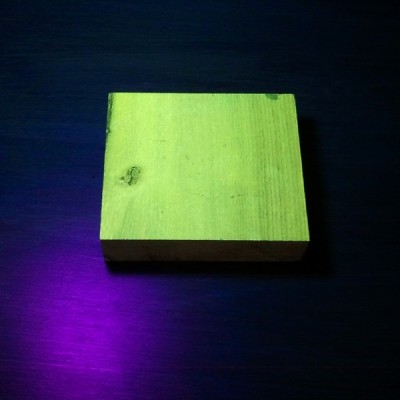
Chemical Testing
There are only a small number of chemical tests regularly used on wood, most of which are very specialized and were developed to help distinguish easily confused species with one another. They work by detecting differences in the composition of heartwood extractives. A chemical substance (called a reagent) is usually dissolved in water and applied to the wood surface: the surface is then observed for any type of chemical reaction (and accompanying color change) that may occur. Two of the most useful are the tests that are meant to separate Red and White Oak, and Red and Hard Maple.
Heartwood Extractives Leachability
Sometimes a wood species will have heartwood extractives that will be readily leachable in water and capable of conspicuously tinting a solution of water a specific color. For instance, the heartwood extractives contained in osage orange (Maclura pomifera) contain a yellowish-brown dye that is soluble in water. (This can sometimes be observed anecdotally when the wood is glued with a water-based adhesive: the glue’s squeeze-out is an unusually vibrant yellow.)
In a simple water extract color test, wood shavings are mixed with water in a vial, test tube, or other suitably small container, and the color of the water is observed after a few minutes. If the heartwood extractives are leachable by water, then a corresponding color change should quickly occur.
In addition to osage orange (Maclura pomifera), merbau (Intsia spp.), and rengas (Gluta spp. and Melanorrhoea spp.) are also noted for their readily leachable heartwood extractives. Because this property is quite uncommon, it can serve to quickly differentiate these woods from other lookalikes.
7. Look at the endgrain.
Perhaps no other technique for accurate identification of wood is as helpful and conclusive as the magnified examination of the endgrain. Frequently, it brings the identification process from a mostly intuitive, unscientific process into a predictable, repeatable, and reliable procedure.
Looking at the endgrain with a magnifier shouldn’t be a mystifying or esoteric art. In many cases, it’s nearly as simple as examining small newsprint under a magnifying glass. There are three components necessary to reap the full benefits contained in the endgrain:
I. A prepared surface.
When working with wood in most capacities, it becomes quickly apparent that endgrain surfaces are not nearly as cooperative or as easily worked as face grain surfaces. However, in this case, it is absolutely critical that a clear and refined endgrain surface is obtained.
For a quick glance of a softwood sample, a very sharp knife or razor blade can be used to take a fresh slice from the endgrain. However, in many denser species, especially in tropical hardwoods, one of the best ways to obtain a clear endgrain view is through diligent sanding. It’s usually best to begin with a relatively smooth saw cut (as from a fine-toothed miter saw blade) and proceed through the grits, starting at around 100, and working up to at least 220 or 320 grit, preferably higher for the cleanest view.
II. The right magnifier.
It need not be expensive, but whatever tool is used to view the endgrain should have adequate magnifying power. In most instances, 10x magnification is ideal, however, anything within the range of 8 to 15x magnification should be suitable for endgrain viewing. (Standard magnifying glasses are typically in the range of 2 to 4x magnification.)
These stronger magnifiers, sometimes called loupes, usually have a smaller viewing area than standard magnifying glasses. Fancier models—with built in lights, or larger viewing surfaces—are available at a premium; but the most basic models are usually only a few dollars.
III. A trained eye.
The third element that constitutes a proper endgrain examination is simply knowing what to look for. In analyzing the patterns, colors, shapes, and spacing of the various anatomical features, there is a veritable storehouse of information within the endgrain—all waiting to be unlocked. Yet, if these elements have not been pointed out and learned, the array of features will simply seem like an unintelligible jumble. The discipline of recognizing anatomical endgrain features is not easily summed up in a few sentences or even a few paragraphs, but it is nonetheless critical to the identification process. To this end, an in-depth look should be given to the various categories, divisions, and elements that constitute endgrain wood identification on the macroscopic level. (In this regard, macroscopic denotes what can be seen with a low-powered, 10x hand lens—without the aid of a microscope—rather than simply what can be seen with the naked eye.) Because the anatomy between softwoods and hardwoods is so divergent, each will be considered and examined separately:Still stumped?
If you have a mysterious piece of wood that you’d like identified, you’ve got a few options for next steps:USDA’s Forest Products Laboratory
You can mail your physical wood samples to the Center for Wood Anatomy Research.
Pros:
- Free
- Professional wood identification
Cons:
- Only available to US citizens
- Slow turnaround times (up to a month or more)
- Limited to three IDs per year
See their Wood ID Factsheet for more info.
Alden Identification Service
You can mail your physical wood samples (even small sections taken from antiques) to Alden Identification Service.
Pros:
- Professional wood identification
- Faster turnaround times (ranging from a few days to a week or two)
Cons:
- Paid service
See their ordering page for more info. (Note that Harry Alden has written several books while at USDA, including both Hardwoods and Softwoods of North America.)
Ask for help online
If the wood ID is merely a curiosity, or non-critical, you can post pictures of the wood in question.
Pros:
- Free
- No need to send physical samples
Cons:
- Greatly limited by the quality of the pictures provided
- Extra work usually required to get adequate clarity in photos
See article of Common US Hardwoods to help find the most commonly used woods.
Get the hard copy
 If you’re interested in getting all that makes The Wood Database unique distilled into a single, real-world resource, there’s the book that’s based on the website—the Amazon.com best-seller, WOOD! Identifying and Using Hundreds of Woods Worldwide. It contains many of the most popular articles found on this website, as well as hundreds of wood profiles—laid out with the same clarity and convenience of the website—packaged in a shop-friendly hardcover book.
If you’re interested in getting all that makes The Wood Database unique distilled into a single, real-world resource, there’s the book that’s based on the website—the Amazon.com best-seller, WOOD! Identifying and Using Hundreds of Woods Worldwide. It contains many of the most popular articles found on this website, as well as hundreds of wood profiles—laid out with the same clarity and convenience of the website—packaged in a shop-friendly hardcover book. 


Why I will no longer be replying to every wood ID request I’ve replied to literally thousands of wood ID requests on this site over the past 13+ years, but as the site’s popularity has grown, so has the time demands for ID on a daily basis. (Contrary to what some may seem to think, I am not some all-knowing wood wizard that can instantly ID your wood. It can actually take me a long time to sift through a lot of different resources.) Over the past few years, my backlog of pending wood species to be added to the… Read more »
40 yr old bookcases. Very light. Paneling on back.
Looks like a softwood species such as pine or fir.
Anyone know what type of wood this is?
Hmm, to me that looks like a less expensive wood like birch that’s been stained a reddish brown to look like mahogany.
What do you think this is? It’s super super light and it’s part of a bed frame. Thinking pine ?
Can’t really tell much about the wood as it appears to be stained and all features of the wood are obscured. Light weight and dark stains usually indicate a cheaper wood species, so perhaps a softwood, or a utility wood like poplar.
Anyone can tell what this is?
The regularly spaced knots would indicate a softwood species such as pine.
Hardwood flooring trying to match. Anyone know for sure what type? Thanks in advance.
Looks like maple, or possibly birch. They both tend to yellow over time, so you’d want to try to maybe add a little yellow tint if you wanted to try to match fresh wood to older stuff.
Thanks so much. I’ll try it!
What type of wood is this does anyone know? Many thanks :)
I found this wood in the attic of an Indianapolis garage built in 1950. I have no idea how long the wood was stored there. (Purchased home in 2012). I am not sure what type of wood this is, but would like to use outdoors with exposure to wind, rain, snow. Could some one help identify please? There are 10 linear boards roughly 11/16″ ×7.25″x8′.
I have attached photos of three boards showing grain, end grain, reddish orange unfinished color, and sticker on board stating Alexandria, VA as point of purchase (?).
Thanks!
The international export sticker definitely adds a layer of uncertainty into the mix. Have you tried sanding/sawing the wood and checking for a scent? It looks like a type of cedar to me.
Yes, the sticker threw me for a loop, too. I also thought it might be cedar, but it was not used anywhere in the build of the house. The house has original cedar siding, but this is not siding. I think I will give it a go and use outdoors. Can’t hurt to try, and if it lasts 10 years I’ll be happy.
Thanks for your reply!
Hi Eric, please see my pictures (chairs) about 10 inquiries down the list; you suggested I re-submit them on my original inquiry, and I finally got them posted. Thanks so, so much as always for the incredible help you provide; so deeply appreciated!!
Hi, I bought this framed mirror 40 years ago and can’t for the life of me remember what wood the frame is. Wondered if you could help identify it please. I can’t dig my nail into an edge as you advised in your text. The back of it isn’t finished in any way and is slightly darker in a red/orange colour than the front. Although I bought it here in the UK, the store sells items from all over the world so can’t offer any help with its origins sorry. Any help would be much appreciated but understand that might… Read more »
It looks very similar to cherry. Being from the UK, it may be more likely to be pear though.
Hi! I’m stripping paint from a bookcase made by my grandfather ~60 years ago. VERY hard wood, slight rose tint to wood, and very light. Any idea what kind of wood this is? Thank you!
Looks like a type of softwood such as pine.
Eric, it’s definitely NOT a softwood! Extremely hard to even dent it.
Softwood is a botanical designation, it is a cone-bearing tree. Some softwoods are hard, including some pines.
Interesting. Thank you for educating me! However, I’ve seen pine in the unfinished state before, and it doesn’t have the pinkish tint that this wood has.
Are you aware that there are dozens of different types of commercial pines? https://www.wood-database.com/pine-wood-an-overall-guide/
Eric, thank you for opening my eyes! I looked at the photos, and saw one of sanded red pine that looks EXACTLY like what I have. Also thought it was unusual that it’s not usually used for furniture making. Wish my grandfather was still alive so that I could ask why he used it!
Good afternoon
I have just finished restoring this salad bowl. It’s probably 50 years old.
It’s quite hard and has a very distinctive white patch.
Any thoughts on what wood it might be would be very welcome.
Thanks
Anthony C
It’s a ring porous hardwood, and that white patch is just the sapwood. I’m not familiar enough with what might have been commonly used in England to say what it may be. Possible guess might be elm or walnut.
Eric, good morning and thank you for your response. My immediate thought was elm, but I hadn’t realised that the sap wood was so white. Walnut was more commonly used to make salad bowls, and as you point out also has a light coloured sap wood. So it is narrowed down to the two. Thanks again. Anthony
Some old reclaimed wood from a job my late father did years ago I found in the rafters of his old shed. Some type of hard wood maybe cherry or walnut but came out of old church maybe floor or wall boards because they are tongue and groove.
What is this wood
Looks like oak.
Any idea what type of wood this is? Thank you!
Hoping you can help! Not sure what type of wood this is but I do know they out of the old north church in Boston. They’re 1 x 4 for the most part, tung and groove. Not very heavy but not light either. Can dent edge with nail but not much. Pics are saw cut sanded end. Saw dust is brownish red. My late father thought it was maybe cherry or walnut.
What is this timber?
Here is another one that I am curious of.
We have some wood that we milled and identified using a phone app. I am curious how correct the app is, because two of the logs are showing to be non native to our location. Here are pictures of the first one.
I don’t think there’s any possible way that an app could give a correct ID based on those pictures.
Do you happen to have any pictures of the endgrain? Please post clear, closeup, finely sanded pics of the endgrain.
I will do that this weekend. And your book delivers tomorrow. I am looking forward to learning more about wood.
Thank you so much
I’m refinishing a dining table purchased st Pier 1 Imports for friends. I have the legs stripped & this is the grain. Any idea what species this is?
I got this MCM table with veneer top and I’d love to have the veneer damage fixed. Do you know what this top might be? From what I understand, this type of table is usually veneered with either walnut, teak, or rosewood. The photos were taken inside using natural light. Any clues is much appreciated.
It appears rosewood would be a good possibility. I think you’d want to focus more on trying to find a piece of veneer with similar grain patterns rather than finding exact species, but rosewoods should get you in the ballpark in terms of appearance here.
I see. Thanks for helping identifying it. Should I get the quarter/flat/different cut of veneer?
That grain is flatsawn.
Any idea what this wood is?
Only tree I’ve seen with that coloration is box elder, but it may be something else too.
Hi, Hopefully this should be an easy one.
Pub table tops?
normally on these black heavy metal stands
Hello. I am trying to identify this wood. I’m told it came from a tree in China but I have no means to verify. It is extremely heavy and very dense. Sawdust has no real aroma to either.
Hi Eric!!!! I trust/hope you got through the pandemic ok!!! About 3 years ago you made my day, week (maybe month) by telling me a clock I got on Goodwill.com was probably Walnut, after I’d considered myself too optimistic/unrealistic to hope it might be mahogany!!! I’m still thrilled to this day over it: my one big (relatively) score in thrift shopping!! Hurray Eric!!! I just got 2 chairs which may be very cheap or maybe high-end. I can live with either (I am still after all this time so happy to have a walnut clock!!), even if my chairs are… Read more »
Can you re-try attaching the pictures? They didn’t come through.
are these photos ok? sorry for delay posting them; computer hardware issues!
Sorry best pictures I have right now; hope they’re good enough to identify wood! Thanks so much as always!
Can someone identify the wood. I am guessing walnut.
I am seeking assistance in identifying this type of wood. I am somewhat familiar with the maker and know that he has used paduak, walnut and rosewood woods, among others, for this instrument. Even after looking at pictures of various woods, I am unsure. Thank you in advance for any insight.
It looks like a diffuse porous tropical hardwood, but beyond that I can’t tell. It doesn’t look like any of the woods you mentioned in your comment.
Can anyone tell me what kind of wood this live edge table is? It was purchased in the 1970s and has no markings on the bottom. Thanks!
I picked up some heavy wood from someone that thought this was oak. The surface under the bark is very wavy. Can you help me ID this wood?
Looks like mesquite
I guess it might be mesquite. The couple mesquite trees I have cut up had a dark brown heartwood and very thick stringy bark. This tree has reddish heartwood.
Piece of wood from a pallet. Might be pine? Pls help me identify it.
I found this piece in a relative’s garage in England. He was a woodturner. It is hard and dense. I thought it might be some type of mahogany.
Got this at a hardwood store bout 40 yrs ago. Wood is aprox 8″ wide and 3/4″ thick. Am hoping you can identify. Heavy like rosewood, havent tried to float it.
Is it Miranti? Fits the weight description and miranti can have that mahogany color.
Hello. I’ve been cleaning up an old table that’s been through a lot (storage in a basement, things piled on it, and coastal storm surges from two hurricanes). After sanding to remove a finish, and oxalic acid to remove water stains (which, it’s not unlikely, lightened the wood in general), this is what I have:
Looks like a species of softwood, probably pine. The regularly spaced knots, as well as what appear to be resin canals visible even from the face grain would all point to pine.
Any chance of identifying what wood our dining table is made of?
Looks like some very old-growth southern yellow pine.
download The google app and select little camera in search bar, take picture of the table from the long side and see if the table comes up, often it will, if the chairs came with the table they would be even easier to image search, good luck I’m curious about this wood too
Can anyone tell me what this species is? The pictures are of sanded face and end grain of a 2″ rough board.Thanks
I’m looking to ID a similar white fine straight grained wood, I’m wondering if it’s maple, one piece has an odd, possibly curly figure look to it ;?) It’s from a director’s chair made back in the 1980’s if that’s any help, lol.
I’m guessing maple most likely.
Could be Obeche. I have had the wood for 40 years.
Hi, Eric: An old friend of mine is looking for an ID. He said this piece has been sitting out in the elements for years (North Alabama). There’s no rot and no sign of any bugs. It’s dense and heavy, and, quote, “cuts like it’s iron.” Thought I’d bounce it off you now that he’s turned it some.
I don’t know of any native trees that would be that heavy and hard and still have a ring porous structure to it like that piece. The only thing I could think of would be some freakishly dense hickory, as that’s the closest looking wood that comes to mind.
Can anyone help me identify the wood type contents of the rest of the axe such as the blade. This ceremonial axe from Congo, believed to be the Lega Tribe, maybe Warega….
Re posting just now about JW dresser ca 1960. More photos – didn’t previously attach.
Hi Eric. Your website is very informative. But unfortunately I still haven’t been able to identify the bedroom dresser I inherited which was made by John Widdicomb Co of Grand Rapids, Michigan circa early 1960’s. It was considered rather high end ‘designer’ furniture at the time and was originally finished in white with painted gold trim, and was refinished in medium brown about 12 years ago. Underneath and inside drawer photos presumably represent original interior finish. The wood seems relatively heavy to me, but as a petite woman I’m probably not a reliable judge. I am hoping that you can… Read more »
The drawer sides at least appear to be solid oak. But I can’t tell on the rest of the piece, especially the top, since the grain is very plain with not a lot of features to go on.
Hi! I’m wondering what kind of wood this coffee table is made out of…I bought it at goodwill and removed a honey colored finish. The table is moderately heavy.
Thanks so much!
– Cristina
Possibly ash? It appears to be a ring porous hardwood, but I can’t see any ray fleck, otherwise I’d say oak.
Hey! great article, I had no idea about the USDA wood ID service, that is super cool! I was hoping to get some direction on this slab I’m looking to ID, the online ad only has this picture but it looks fairly unique in its characteristics so I was hoping it might be enough for a genus or family of tree perhaps. A couple people in another group said its a spine of pine, but others said that wasn’t correct so I’m a bit lost. I’m waiting on extra details from the guy selling it, but figured it was worth… Read more »
Spalted Maple?
I believe this is Sycamore
Hey,
I got this window from a carpenter. But I’m afraid whether he used the correct wood or not.
Can you tell what wood is this?
Hi Eric, I’d like to ask a general question about obtaining an estimate of the specific gravity (12% MC) of a piece of wood. My normal approach, where possible, is to cut a rectangular sample of the unknown wood, measure all 3 dimensions to calculate the volume, then weight the sample & derive the grams/cm3 value. (Otherwise I’d immerse the piece of wood in a measuring jug to see what volume it displaces). I do this to the sample once it has been left indoors (CH house) for a while. I’m assuming the value derived would approach the 12% MC… Read more »
A lot will depend on the relative humidity where the wood has been stored, and if the wood has had adequate time to reach equilibrium moisture content with the surrounding air. You can see a chart in this article where it shows the moisture level that corresponds to the relative humidity of the air. https://www.wood-database.com/wood-and-moisture/
Hiya Eric, calling from Australia. I bought this repro? Art Deco hall stand at a recent auction with amazing solid show wood, but am unable to identify it. Would appreciate any help. Kindest regards Kelly.
Possibly silky oak veneer?
These are from a fallen house that looks like the wood was harvested and milled on site. The house was built at least 100 years ago and appears to have collapsed at least 20 years ago. The wood used is a mix of oak, pine, eastern cedar (Juniper) and this species. The oak and pine were mostly hand hewn logs wit a lot of rot, especially in the pine. There is very little rot in this species, considering that the house is just a pile of rubble. All pieces are heavily weathered, some pieces are completely solid, others are “wormy”… Read more »
It looks like some old heart pine to me, though it could be Douglas fir too. I can see the resin canals in the latewood sections, which both pine and douglas fir would have. Not chestnut.
Hello Eric! I have a piece of a board that was left from my grandfather. I have tried to figure out what type of wood it is and am pretty sure it’s some sort of Rosewood. When worked the wood has a fairly powerful sweet&spicy scent. The wood is heavy but not as heavy as ebony, however it has likely been stored in a dry environment for atleast 2 or more decades so maybe that has affected it? Unfortunately I only had this small piece available for photos (which are taken on my phone) but maybe you have a chance… Read more »
Yes, I would agree that it does appear to be a likely candidate for a genuine rosewood species. It would be difficult to get a more precise ID without knowing what continent this came from, as the most likely sources would be Asia, Africa, and South America.
Thanks Eric!
I don’t know what continent it is from but the most likely is probably South America.
Looks a lot like Bocote to me.
Hi. Trying to figure out what species of wood this is. This is framing from a house in Massachusetts built in 1920. I personally want to say it smells oaky when cut, but maybe there are other woods that also smell oaky — I really don’t know. It feels hard-ish, but is super dry and quite light. Definitely not nearly as dense or hard as modern red oak that I would buy from a lumber yard. I can compress it somewhat easily in a vice and it’s rather splintery. Any help would be greatly appreciated. Thanks.
It’s very hard to make out the grain as it seems to be in a very rough sawn state. Judging from the little bit of smooth areas I can make out on the endgrain just on the outer rim of the knot, it does look like a species of softwood (like pine or fir) and not oak.
Thanks for looking. I don’t know if it helps but here’s some more pics taken with cleaner cuts. Also took one with my 60x pocket microscope but maybe that’s too much mag to be useful. Anyway, at the very least knowing it’s not oak is a huge help. Thanks again.
Yeah, it does look like a softwood on the face grain. That microscope shot would actually be really nice, but the surface is still too rough to see the details. You’d really need to sand it down further to a smooth surface, the microscope shot serves to show just how much fuzzy stuff is still obstructing the view.
I found this dinning room set. I need to make a leaf for the table so I’m curious what type of wood this is.
I bought an assorted lot of rough lumber from an old sawyer. Im in southern illinois. I dont know what this guy is. Its super dense.
Possibly sycamore. Would need to see a clearer picture, especially of the endgrain, to tell more.
Hey thanks Eric,
I do believe you’re correct. The google machine showed similarly, once the it was named correctly.
Thanks again!
Hi this wood came from a construction beam. I couldn’t get high definition photos cuz my phone rear camera is broke but, I try to compensate with editing hope it would be clear.
Wood dents with finger nail rather easy, planes bit harder than what I believe, I had is pine from a salvaged pallet (yellow) Thank you for your effort. I forgot the add pictures comment before sorry! Couldn’t add after seems like
I’m really not familiar with what woods would be available in Turkey, and I can’t see much from the pics. But if I had to guess, those knots and the overall whiteness of the grain definitely remind me of poplar/aspen in the Populus genus.